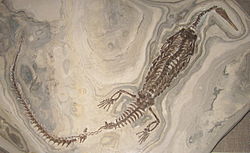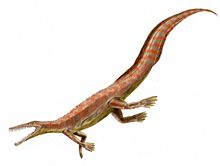- Mesosaurus
-
Mesosaurus
Temporal range: Cisuralian, 299–280 Ma
Mesosaurus tenuidens Scientific classification 
Kingdom: Animalia Phylum: Chordata Class: Reptilia Order: †Mesosauria Family: †Mesosauridae Genus: †Mesosaurus
Gervais, 1864-66Species: †M. tenuidens
Gervais, 1864-66Synonyms - Mesosaurus brasiliensis McGregor, 1908
- Ditrochosaurus capensis Gurich, 1889
- Mesosaurus capensis (Gurich, 1889)
Mesosaurus (meaning "middle lizard") is an extinct genus of reptile from the Early Permian of southern Africa and South America. Along with the genus Stereosternum, it is a member of the family Mesosauridae and the order Mesosauria. Mesosaurus was one of the first marine reptiles, and had many adaptations to a fully aquatic lifestyle. It is usually considered to have been anapsid, although Friedrich von Huene considered that it was synapsid[1], and this hypothesis has been revived recently[2].
Contents
Description
Mesosaurus had a long skull that was larger than that of Stereosternum and had longer teeth. The teeth are angled outwards, especially those at the tips of the jaws.[3]
The bones of the postcranial skeleton are thick, having undergone pachyostosis. Mesosaurus is unusual among reptiles in that it possesses a cleithrum. A cleithrum is a type of dermal bone that overlies the scapula, and is usually found in more primitive bony fish and tetrapods. The head of the interclavicle of Mesosaurus is triangular, unlike those of other early reptiles, which are diamond-shaped.[4]
Palaeobiology
Mesosaurus was one of the first reptiles to return to the water after early tetrapods came to land in the Late Devonian or later in the Paleozoic[5]. It was around 1 metre (3.3 ft) in length, with webbed feet, a streamlined body, and a long tail that may have supported a fin. It probably propelled itself through the water with its long hind legs and flexible tail. Its body was also flexible and could easily move sideways, but it had heavily thickened ribs, which would have prevented it from twisting its body.[6]
Mesosaurus had a small skull with long jaws. The nostrils were located at the top, allowing the creature to breathe with only the upper side of its head breaking the surface, in a similar manner to a modern crocodile. The teeth were originally thought to have been straining devices for the filter feeding of planktonic organisms.[6] However, this idea was based on the assumption that the teeth of Mesosaurus were numerous and close together in the jaws. Newly examined remains of Mesosaurus show that it had fewer teeth, and that the dentition was suitable for catching small nektonic prey such as crustaceans.[3]
 Early reconstruction of the skeleton of M. brasiliensis showing many small teeth in the jaws (MacGregor, 1908).[7]
Early reconstruction of the skeleton of M. brasiliensis showing many small teeth in the jaws (MacGregor, 1908).[7]
The pachyostosis seen in the bones of Mesosaurus may have enabled it to reach neutral buoyancy in the upper few meters of the water column. The additional weight may have stabilized the animal at the water's surface. Alternatively, it could have given Mesosaurus greater momentum when gliding underwater. While many features suggest a wholly aquatic lifestyle[8], Mesosaurus may have been able to move onto land for short periods of time. The elbows and ankles had restricted movement, making walking impossible. It is more likely that if Mesosaurus moved onto land, it would push itself forward in a similar way to living female sea turtles when nesting on beaches.[4]
Distribution
Mesosaurus was significant in providing evidence for the theory of continental drift, because its remains were found in southern Africa and eastern South America, two far away places[1]. As Mesosaurus was a coastal animal, and therefore could not have crossed the Atlantic Ocean, this distribution indicated that the two continents used to be joined together.
References
- ^ a b Huene, F. von (1940). "Osteologie und systematische Stellung von Mesosaurus". Palaeontographica. Abteilung A. Palaeozoologie-Stratigraphie 92: 45–58.
- ^ Piñeiro, Graciela (2008). "Los mesosaurios y otros fosiles de fines del Paleozoico". In D. Perera. Fósiles de Uruguay. DIRAC, Montevideoy.
- ^ a b Modesto, S.P. (2006). "The cranial skeleton of the Early Permian aquatic reptile Mesosaurus tenuidens: implications for relationships and palaeobiology". Zoological Journal of the Linnean Society 146 (3): 345–368. doi:10.1111/j.1096-3642.2006.00205.x.
- ^ a b Modesto, S.P. (2010). "The postcranial skeleton of the aquatic parareptile Mesosaurus tenuidens from the Gondwanan Permian". Journal of Vertebrate Paleontology 30 (5): 1378–1395. doi:10.1080/02724634.2010.501443.
- ^ Laurin, Michel (2010). How Vertebrates left the Water (illustrated ed.). University of California Press. pp. xv + 199. ISBN 978-0-520-26647-6.
- ^ a b Palmer, D., ed (1999). The Marshall Illustrated Encyclopedia of Dinosaurs and Prehistoric Animals. London: Marshall Editions. p. 65. ISBN 1-84028-152-9.
- ^ MacGregor, J.H. (1908) Mesosaurus brasiliensis nov. sp. IN: White, I.C. (1908) Commission for Studies on Brazilian Coal Mines - Final Report; (Bilingual report, Portuguese & English), Imprensa Nacional, Rio de Janeiro, Brazil, 617 p.: Part II, pp. 301-336.
- ^ Canoville, Aurore; Michel Laurin (2010). "Evolution of humeral microanatomy and lifestyle in amniotes, and some comments on paleobiological inferences". Biological Journal of the Linnean Society 100 (2): 384–406.
- Parker, Steve. Dinosaurus: the complete guide to dinosaurs. Firefly Books Inc, 2003. Pg. 90
- Carroll, R. L. (1988). K. Behrensmeyer/K. Behrensmeyer/J. Alroy. ed. Vertebrate Paleontology and Evolution. W.H. Freeman and Company.
- LeGrand, Homer Eugene (1988). Drifting Continents and Shifting Theories: The Modern Revolution in Geology and Scientific Change (illustrated ed.). Cambridge University Press. pp. 313. ISBN 0521311055, 9780521311052.
- Margulis, Lynn; Clifford Matthews and Aaron Haselton. Environmental Evolution: Effects of the Origin and Evolution of Life on Planet Earth. Contributor Clifford Matthews, Aaron Haselton (2nd ed.). pp. 338. ISBN 0262631970, 9780262631976.
- Sepkoski, J. J. (2002). "A compendium of fossil marine animal genera". Bulletins of American Paleontology 363: 1–560.
Categories:- Prehistoric reptiles
- Marine reptiles
- Permian reptiles
- Mesosaurus brasiliensis McGregor, 1908
Wikimedia Foundation. 2010.



